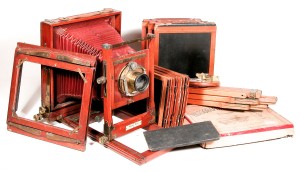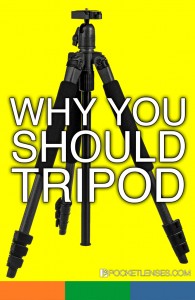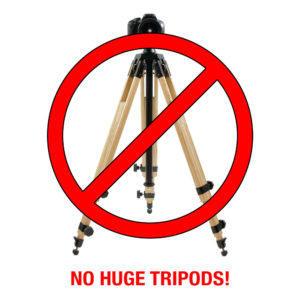
These tips apply to ALL cameras (including smartphones!)
At the end of this article, I’ll have some recommendations for some nice, super light, mobile tripods …
One of the easiest ways to quickly and significantly improve the images you make is by using a tripod. There are several reasons why you should use a tripod.
 A tripod will slow you down. (This is actually a good thing.)
A tripod will slow you down. (This is actually a good thing.)
Long ago, when cameras were huge and bulky, hand holding them wasn’t even a consideration. You needed a solid, sturdy and heavy tripod just to get the shot. Ansel Adams shot many of his famous works in Yosemite using just this kind of large camera. The tripod allowed you to open the shutter for a longer time without worrying about camera-shake that could cause blur. Setting up the tripod was quite the process. You had to plan where you would set up your tripod and camera: evaluate the scene, level the tripod, attach the (heavy) camera, put the (expensive) film plate in, set your focus, and expose the film, (opening and closing the shutter manually). Whew! This complicated process surely ensured that photographers were not going to risk squandering money or getting a bad shot because they were in a hurry or careless. Everything they did was planned, thoughtful, intentional and designed to get the best picture that they could. They considered the lighting, the position of the camera, the placement of subjects within the frame, the composition, all of this before they opened the shutter. Fast forward to the present where I’ve seen so many people walk and snap pictures while they are moving around. Now given, today’s cameras are a lot more advanced than the view cameras of old, but some things still apply. Take the time to set up your shot, compose it, check the lighting, be thoughtful about it and you’ll get more usable images than if you just quickly fired away. Slowing down is a good thing. Allow yourself the margin of time and freedom to not rush through your photo shoot, whether you’re making a photo of a flower, a mountain range or a group of people. Let the tripod slow you down and take the time to get the shot right.
A tripod will hold your camera steadier than your hands ever will.
Using a tripod is essential if you are shooting in low light (i.e. night shots) or if you ever want to keep your shutter open longer than usual (i.e. letting a waterfall blur for a soft, silky effect). You’ll also be able to use a lower ISO (which means less grain and “noise” in your photos). If you ever need to steady your camera because of low light, slow shutter speeds or because you’ve had a little too much caffeine, a tripod is your best bet.
A tripod will let you be in the photo.
How many times have you been left out of a group photo because you were the one taking the photo? Sure if you’re in a well populated place you could ask someone else to take the picture for you, but you run a couple risks. 1) The person you hand the camera to is really bad at taking pictures, shakes the camera, blurs the shot, cuts off heads, or puts their finger over the lens. 2) The person you hand the camera to is a camera thief and an athletic sprinting track star. Once you’re posing with your group, he takes off and bang zoom, it’s the last you see of your camera. A tripod is especially useful when you’re someplace that isn’t well populated (with either honest people or thieving track sprinters) like hiking in the great outdoors. Look for a nice background, pay attention to where the light is coming from, attach your camera, set group peeps in place, then either use the camera timer or use a wireless remote (more on this in a bit) and fire away! Voila! You’re no longer left out of the group shot and you didn’t even risk donating your camera to running-camera-thief’s camera collection!
When most people think about tripods they envision large, clunky contraptions that are bulky and inconvenient to carry around. This doesn’t have to be the case. With clever designs and today’s materials, there are many tripods that are relatively compact, lightweight and easy to use. With a heavy digital SLR camera, you may need to have an appropriately heavy tripod to keep it from shaking / vibrating. However, with a lighter pocket sized camera you may not need all the bulk. I’ll have some suggestions of nice and super-light tripod options for you at the end of this article.
 Extra bonus tip and trick: If your tripod is really light and you’re concerned that it might shake or even blow over in strong wind, add some weight. Here’s what I do. Bring a little string / cord. Hang your backpack / camera bag from the center column as a weight. Make sure it’s not swinging. You’ve just added weight and stability to your tripod without having to carry around a heavy tripod the whole time. Heavy and stable when you need it, light and agile when you don’t.
Extra bonus tip and trick: If your tripod is really light and you’re concerned that it might shake or even blow over in strong wind, add some weight. Here’s what I do. Bring a little string / cord. Hang your backpack / camera bag from the center column as a weight. Make sure it’s not swinging. You’ve just added weight and stability to your tripod without having to carry around a heavy tripod the whole time. Heavy and stable when you need it, light and agile when you don’t.
Extra, extra bonus tip and trick: Use a wireless remote shutter release OR the camera timer. Most cameras will give you the option to use a wireless remote to trigger your shutter. Most are brand and model specific. Some use infrared (IR) to transmit a signal and others use radio frequency (RF). I go for the RF choice when I can. IR works OK, but it’s more limited in range and since it uses light (infrared light) to send a signal, it can get “confused” by bright light and heat sources. RF transmitters are generally reliable and transmit a pretty good distance. Use these and you can get in the shot and trigger the camera once you’re in place. This also gives you the advantage to calmly walk over to the group, get yourself in place and trigger the camera on your own time without the typical panic of running to beat the timer. You’ll also be able to take multiple pictures with the remote just in case someone blinks.
Extra, extra, extra bonus tip and trick: Don’t use a tripod on the deck of a moving boat or the back of a camel, it’s pointless … as was this last tip.
Head over to my camera gear page to see my recommendations of some light and agile tripods, including a little universal smartphone mount for tripods.
Your Assignment: Get out and practice using a tripod. The more that you’re comfortable with your tripod the more it will become a useful part of your photographic arsenal to get great shots.
5 ways to hone your photography skills


I never thought about a tripod for my iPhone. What a great idea…I am always taking pictures and never in them.
Do you have any recommendations for a small but sturdy tripod for smart phones? I’m thinking something I could attach to a tree, branch, or pole without worrying about if it will fall while holding my expensive smart phone.
Yup! Head over to my recommended gear page here.
Regarding your “extra, extra bonus tip and trick”, another reason to use the camera’s self-timer even if you’re not trying to get into the picture is that a lightweight tripod may be springy enough that it can’t hold the camera still while your hand is touching it. By using the timer, you can press the button and let go, and there’s time for vibrations to die away before the shutter opens.This applies mainly to low light conditions when you use a slow shutter speed (or the camera chooses a slow one for you).
Good tip. As one get’s a little older the hands are not always quite so steady so using the tripod should improve the quality of my photos.
Thanks